Hier bei WPBeginner haben wir Millionen von Nutzern beraten, wie sie ihre Websites für die Suche optimieren und ihren organischen Traffic erhöhen können. Wir haben festgestellt, dass ein Aspekt der Suchmaschinenoptimierung, der von Anfängern oft übersehen wird, die robots.txt-Datei ist, die Suchmaschinen hilft, Ihre Website zu entdecken, zu crawlen und zu indizieren.
Diese einfache Textdatei dient als Anleitung, die den Suchmaschinen-Bots sagt, auf welche Teile Ihrer Website sie zugreifen sollen und welche sie in Ruhe lassen sollen.
Durch die Optimierung Ihrer robots.txt-Datei können Sie sicherstellen, dass Suchmaschinen sich auf das Crawling und die Indizierung Ihrer wichtigsten Inhalte konzentrieren und verhindern, dass sie Ressourcen für weniger wichtige Bereiche Ihrer Website verschwenden.
In diesem Artikel finden Sie einige Tipps, wie Sie eine perfekt optimierte robots.txt-Datei für Ihre WordPress-Website erstellen und so Ihr SEO-Potenzial maximieren können.
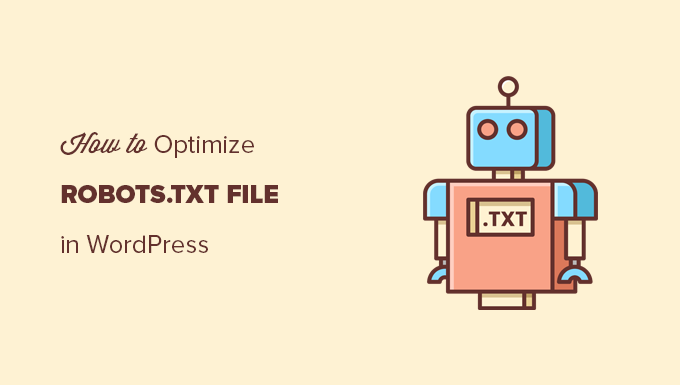
Was ist eine Robots.txt-Datei?
Robots.txt ist eine Textdatei, die Website-Besitzer erstellen können, um Suchmaschinen-Bots mitzuteilen, wie sie die Seiten ihrer Website crawlen und indizieren sollen.
Sie wird normalerweise im Stammverzeichnis (auch als Hauptordner bezeichnet) Ihrer Website gespeichert. Das grundlegende Format für eine robots.txt-Datei sieht wie folgt aus:
User-agent: [user-agent name]
Disallow: [URL string not to be crawled]
User-agent: [user-agent name]
Allow: [URL string to be crawled]
Sitemap: [URL of your XML Sitemap]
Sie können mehrere Zeilen mit Anweisungen haben, um bestimmte URLs zuzulassen oder zu verbieten, und mehrere Sitemaps hinzufügen. Wenn Sie eine URL nicht verbieten, gehen die Suchmaschinenbots davon aus, dass sie sie crawlen dürfen.
So kann eine robots.txt-Beispieldatei aussehen:
User-Agent: *
Allow: /wp-content/uploads/
Disallow: /wp-content/plugins/
Disallow: /wp-admin/
Sitemap: https://example.com/sitemap_index.xml
Im obigen robots.txt-Beispiel haben wir Suchmaschinen erlaubt, Dateien in unserem WordPress-Uploads-Ordner zu crawlen und zu indizieren.
Danach haben wir Suchbots daran gehindert, Plugins und WordPress-Administrationsordner zu crawlen und zu indizieren.
Zum Schluss haben wir die URL unserer XML-Sitemap angegeben.
Brauchen Sie eine Robots.txt-Datei für Ihre WordPress-Website?
Wenn Sie keine robots.txt-Datei haben, werden Suchmaschinen Ihre Website trotzdem durchsuchen und indexieren. Sie können ihnen jedoch nicht mitteilen, welche Seiten oder Ordner nicht gecrawlt werden sollen.
Wenn Sie einen Blog zum ersten Mal starten und noch nicht viele Inhalte haben, wird dies keine großen Auswirkungen haben.
Wenn Ihre Website jedoch wächst und Sie mehr Inhalte hinzufügen, werden Sie wahrscheinlich eine bessere Kontrolle darüber wünschen, wie Ihre Website gecrawlt und indiziert wird.
Hier ist der Grund dafür.
Suchroboter haben eine Crawl-Quote für jede Website.
Das bedeutet, dass sie während einer Crawl-Sitzung eine bestimmte Anzahl von Seiten crawlen. Wenn sie ihr Crawl-Budget aufbrauchen, bevor sie alle Seiten Ihrer Website gecrawlt haben, kommen sie zurück und setzen das Crawlen in der nächsten Sitzung fort.
Dies kann die Indizierungsrate Ihrer Website verlangsamen.
Sie können dies beheben, indem Sie Suchbots daran hindern, unnötige Seiten wie Ihre WordPress-Verwaltungsseiten, Plugin-Dateien und Themes-Ordner zu crawlen.
Indem Sie unnötige Seiten nicht zulassen, sparen Sie Ihre Crawl-Quote. Dies hilft den Suchmaschinen, noch mehr Seiten auf Ihrer Website zu crawlen und sie so schnell wie möglich zu indizieren.
Ein weiterer guter Grund, eine robots.txt-Datei zu verwenden, ist, wenn Sie Suchmaschinen daran hindern wollen, einen Beitrag oder eine Seite auf Ihrer Website zu indizieren.
Dies ist zwar nicht die sicherste Methode, um Inhalte vor der Öffentlichkeit zu verbergen, aber sie hilft Ihnen zu verhindern, dass Inhalte in den Suchergebnissen erscheinen.
Wie sieht eine ideale Robots.txt-Datei aus?
Viele beliebte Blogs verwenden eine sehr einfache robots.txt-Datei. Ihr Inhalt kann je nach den Bedürfnissen der jeweiligen Website variieren:
User-agent: *
Disallow:
Sitemap: https://www.example.com/post-sitemap.xml
Sitemap: https://www.example.com/page-sitemap.xml
Diese robots.txt-Datei ermöglicht es allen Bots, alle Inhalte zu indizieren, und bietet ihnen einen Link zu den XML-Sitemaps der Website.
Für WordPress-Sites empfehlen wir die folgenden Regeln in der robots.txt-Datei:
User-Agent: *
Allow: /wp-content/uploads/
Disallow: /wp-admin/
Disallow: /readme.html
Disallow: /refer/
Sitemap: https://www.example.com/post-sitemap.xml
Sitemap: https://www.example.com/page-sitemap.xml
Dies weist Suchbots an, alle WordPress-Bilder und -Dateien zu indizieren. Es verhindert, dass Suchbots den WordPress-Adminbereich, die Readme-Datei und getarnte Affiliate-Links indizieren.
Durch das Hinzufügen von Sitemaps zur robots.txt-Datei machen Sie es den Google-Bots leicht, alle Seiten Ihrer Website zu finden.
Da Sie nun wissen, wie eine ideale robots.txt-Datei aussieht, sehen wir uns an, wie Sie eine robots.txt-Datei in WordPress erstellen können.
Wie man eine Robots.txt-Datei in WordPress erstellt
Es gibt zwei Möglichkeiten, eine robots.txt-Datei in WordPress zu erstellen. Sie können die Methode wählen, die für Sie am besten geeignet ist.
Methode 1: Bearbeiten der Robots.txt-Datei mit All in One SEO
All in One SEO, auch bekannt als AIOSEO, ist das beste WordPress-SEO-Plugin auf dem Markt und wird von über 3 Millionen Websites genutzt. Es ist einfach zu bedienen und kommt mit einem robots.txt-Datei-Generator.
Weitere Informationen finden Sie in unserem ausführlichen AIOSEO-Test.
Wenn Sie das AIOSEO-Plugin noch nicht installiert haben, können Sie sich unsere Schritt-für-Schritt-Anleitung zur Installation eines WordPress-Plugins ansehen.
Hinweis: Es gibt auch eine kostenlose Version von AIOSEO, die über diese Funktion verfügt.
Sobald das Plugin installiert und aktiviert ist, können Sie damit Ihre robots.txt-Datei direkt in Ihrem WordPress-Adminbereich erstellen und bearbeiten.
Gehen Sie einfach auf All in One SEO “ Tools, um Ihre robots.txt-Datei zu bearbeiten.
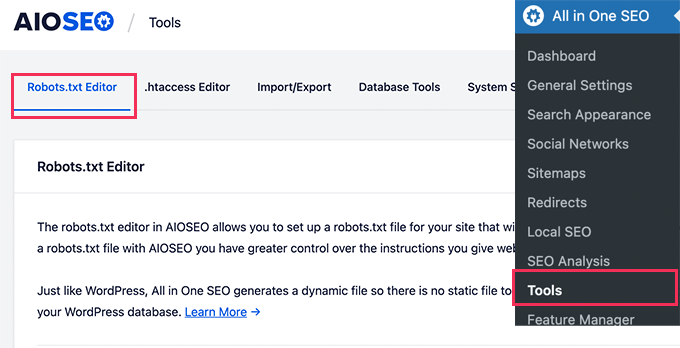
Zunächst müssen Sie die Bearbeitungsoption aktivieren, indem Sie den Schalter „Enable Custom Robots.txt“ auf blau setzen.
Wenn Sie diese Option aktivieren, können Sie eine benutzerdefinierte robots.txt-Datei in WordPress erstellen.

All in One SEO zeigt Ihre vorhandene robots.txt-Datei im Abschnitt „Robots.txt-Vorschau“ unten auf dem Bildschirm an.
Diese Version zeigt die Standardregeln, die von WordPress hinzugefügt wurden.
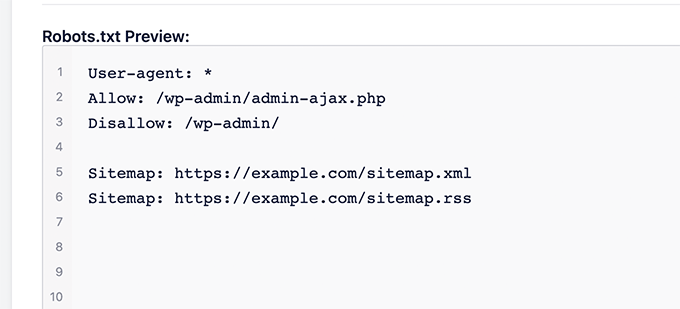
Diese Standardregeln weisen die Suchmaschinen an, Ihre WordPress-Kerndateien nicht zu crawlen, erlauben den Bots, alle Inhalte zu indizieren, und bieten ihnen einen Link zu den XML-Sitemaps Ihrer Website.
Jetzt können Sie Ihre eigenen benutzerdefinierten Regeln hinzufügen, um Ihre robots.txt für SEO zu verbessern.
Um eine Regel hinzuzufügen, geben Sie einen User Agent in das Feld „User Agent“ ein. Wenn Sie ein * verwenden, gilt die Regel für alle Benutzer-Agenten.
Wählen Sie dann aus, ob Sie das Crawlen durch Suchmaschinen zulassen oder verbieten wollen.
Geben Sie dann den Dateinamen oder den Verzeichnispfad in das Feld „Verzeichnispfad“ ein.
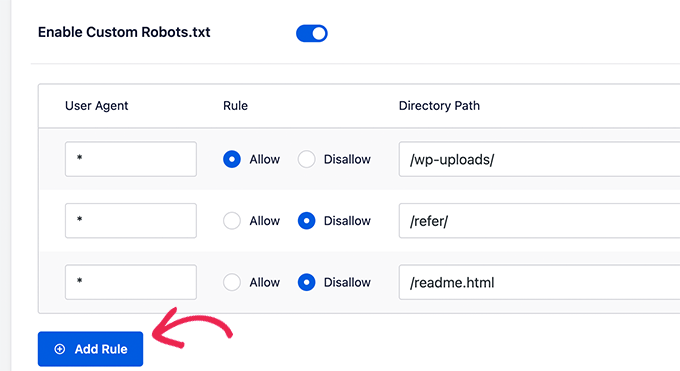
Die Regel wird automatisch auf Ihre robots.txt angewendet. Um eine weitere Regel hinzuzufügen, klicken Sie einfach auf die Schaltfläche „Regel hinzufügen“.
Wir empfehlen, Regeln hinzuzufügen, bis Sie das ideale robots.txt-Format erstellt haben, das wir oben beschrieben haben.
Ihre benutzerdefinierten Regeln sehen dann so aus.
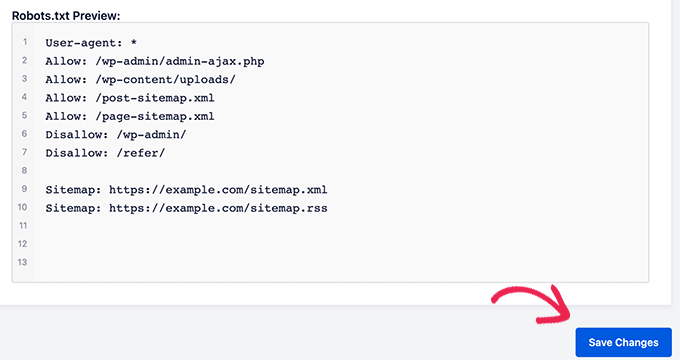
Wenn Sie fertig sind, vergessen Sie nicht, auf die Schaltfläche „Änderungen speichern“ zu klicken, um Ihre Änderungen zu speichern.
Methode 2: Bearbeiten der Datei Robots.txt mit WPCode
WPCode ist ein leistungsfähiges Plugin für Codeschnipsel, mit dem Sie Ihrer Website einfach und sicher eigenen Code hinzufügen können.
Es enthält auch eine praktische Funktion, mit der Sie die robots.txt-Datei schnell bearbeiten können.
Hinweis: Es gibt auch ein kostenloses WPCode-Plugin, das jedoch nicht die Funktion des Dateieditors enthält.
Als Erstes müssen Sie das WPCode-Plugin installieren. Eine Schritt-für-Schritt-Anleitung finden Sie in unserem Leitfaden für Einsteiger zur Installation eines WordPress-Plugins.
Nach der Aktivierung müssen Sie zur Seite WPCode “ File Editor navigieren. Klicken Sie dort einfach auf die Registerkarte „robots.txt“, um die Datei zu bearbeiten.
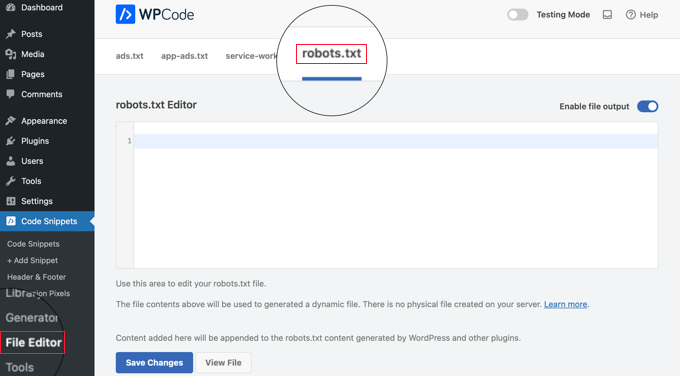
Nun können Sie den Inhalt der robots.txt-Datei einfügen oder eingeben.
Wenn Sie fertig sind, klicken Sie auf die Schaltfläche „Änderungen speichern“ unten auf der Seite, um die Einstellungen zu speichern.
Methode 3: Manuelles Bearbeiten der Datei Robots.txt mit FTP
Für diese Methode müssen Sie einen FTP-Client verwenden, um die robots.txt-Datei zu bearbeiten. Alternativ können Sie den von Ihrem WordPress-Hosting bereitgestellten Dateimanager verwenden.
Verbinden Sie sich einfach über einen FTP-Client mit den Dateien Ihrer WordPress-Website.
Dort können Sie die Datei robots.txt im Stammverzeichnis Ihrer Website sehen.
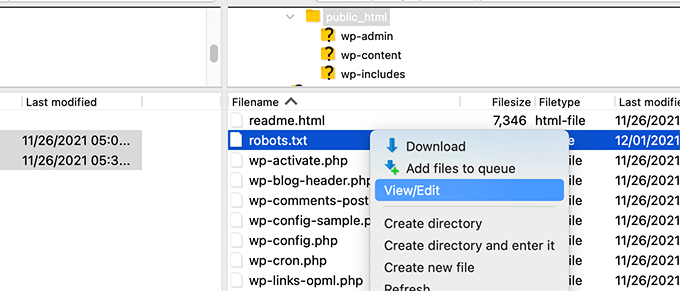
Wenn Sie keine sehen, dann haben Sie wahrscheinlich keine robots.txt-Datei.
In diesem Fall können Sie einfach eine erstellen.
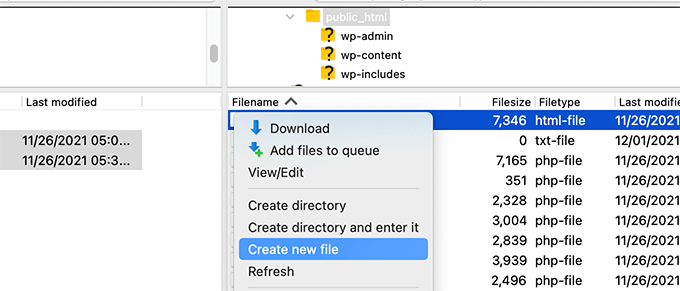
Robots.txt ist eine reine Textdatei, d. h. Sie können sie auf Ihren Computer herunterladen und mit einem beliebigen Texteditor wie Notepad oder TextEdit bearbeiten.
Nachdem Sie Ihre Änderungen gespeichert haben, können Sie die Datei robots.txt wieder in das Stammverzeichnis Ihrer Website hochladen.
Wie Sie Ihre Robots.txt-Datei testen
Sobald Sie Ihre robots.txt-Datei erstellt haben, sollten Sie sie mit einem robots.txt-Testprogramm überprüfen.
Es gibt viele robots.txt-Tests, aber wir empfehlen die Verwendung des Tools in der Google Search Console.
Zunächst müssen Sie Ihre Website mit der Google Search Console verknüpfen. Falls Sie dies noch nicht getan haben, lesen Sie unsere Anleitung, wie Sie Ihre WordPress-Website zur Google Search Console hinzufügen.
Dann können Sie das Google Search Console Robots Testing Tool verwenden.
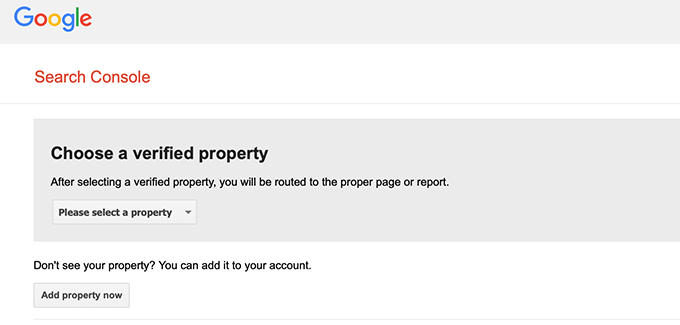
Wählen Sie einfach Ihre Immobilie aus der Dropdown-Liste aus.
Das Tool ruft automatisch die robots.txt-Datei Ihrer Website ab und markiert die Fehler und Warnungen, wenn es welche findet.
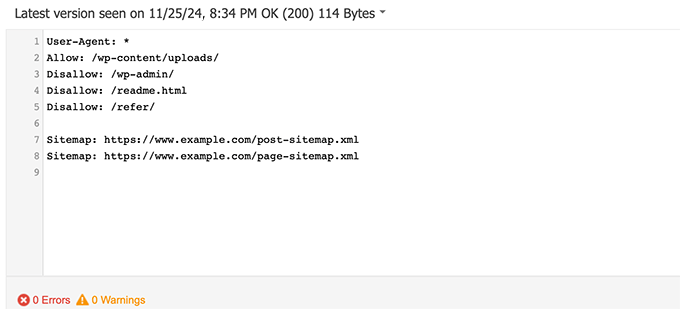
Abschließende Überlegungen
Das Ziel der Optimierung Ihrer robots.txt-Datei ist es, Suchmaschinen daran zu hindern, Seiten zu crawlen, die nicht öffentlich zugänglich sind. Zum Beispiel Seiten in Ihrem wp-plugins-Ordner oder Seiten in Ihrem WordPress-Verwaltungsordner.
Ein weit verbreiteter Mythos unter SEO-Experten ist, dass das Blockieren von WordPress-Kategorien, -Tags und -Archivseiten die Crawl-Rate verbessert und zu einer schnelleren Indizierung und höheren Platzierungen führt.
Das ist nicht wahr. Es verstößt auch gegen die Webmaster-Richtlinien von Google.
Wir empfehlen Ihnen, das obige robots.txt-Format zu befolgen, um eine robots.txt-Datei für Ihre Website zu erstellen.
Expertenanleitungen zur Verwendung von Robots.txt in WordPress
Da Sie nun wissen, wie Sie Ihre robots.txt-Datei optimieren können, möchten Sie vielleicht einige andere Artikel über die Verwendung von robots.txt in WordPress lesen.
- Glossar: Robots.txt
- Wie man eine WordPress-Seite vor Google verbirgt
- Wie man Suchmaschinen davon abhält, eine WordPress-Website zu crawlen
- Wie man eine WordPress-Site dauerhaft aus dem Internet löscht
- Einfaches Ausblenden (Noindex) von PDF-Dateien in WordPress
- Wie man den Fehler „Googlebot kann nicht auf CSS- und JS-Dateien zugreifen“ in WordPress behebt
- Wie man All in One SEO für WordPress richtig einrichtet (Ultimative Anleitung)
Wir hoffen, dass dieser Artikel Ihnen geholfen hat zu erfahren, wie Sie Ihre WordPress robots.txt-Datei für SEO optimieren können. Vielleicht interessieren Sie sich auch für unseren ultimativen WordPress-SEO-Leitfaden und unsere Expertenauswahl der besten WordPress-SEO-Tools für das Wachstum Ihrer Website.
Wenn Ihnen dieser Artikel gefallen hat, dann abonnieren Sie bitte unseren YouTube-Kanal für WordPress-Videotutorials. Sie können uns auch auf Twitter und Facebook finden.





Syed Balkhi
Hey WPBeginner readers,
Did you know you can win exciting prizes by commenting on WPBeginner?
Every month, our top blog commenters will win HUGE rewards, including premium WordPress plugin licenses and cash prizes.
You can get more details about the contest from here.
Start sharing your thoughts below to stand a chance to win!
Steve
Thanks for this – how does it work on a WP Multisite thou?
WPBeginner Support
For a multisite, you would need to have a robots.txt file in the root folder of each site.
Admin
Pacifique Ndanyuzwe
My wordpress site is new and my robot.txt by default is
user-agent: *
Disallow: /wp-admin/
Allow: /wp-admin/admin-ajax.php
I want google to crawl and index my content. Is that robot.txt okay?
WPBeginner Support
You can certainly use that if you wanted
Admin
Ritesh Seth
Great Airticle…
I was confused from so many days about Robots.txt file and Disallow links. Have copied the tags for robots file. Hope this will solve the issue of my Site
WPBeginner Support
We hope our article will help as well
Admin
Kurt
The files in the screenshots of your home folder are actually located under the public_html folder under my home folder.
I did not have a /refer folder under my public_html folder.
I did not have post or page xml files anywhere on my WP account.
I did include an entry in the robots.txt file I created to disallow crawling my sandbox site. I’m not sure that’s necessary since I’ve already selected the option in WP telling crawlers not to crawl my sandbox site, but I don’t think it will hurt to have the entry.
WPBeginner Support
Some hosts do rename public_html to home which is why you see it there. You would want to ensure Yoast is active for the XML files to be available. The method in this article is an additional precaution to help with preventing crawling your site
Admin
Ahmed
Great article
WPBeginner Support
Thank you
Admin
ASHOK KUMAR JADON
Hello, such a nice article you solve my problem. So Thank You so much
WPBeginner Support
Glad our article could help
Admin
Elyn Ashton
User-agent: *
Disallow: /wp-admin/
Allow: /wp-admin/admin-ajax.php <– This is my robot.txt code but im confuse why my /wp-admin is index? How to no index it?
WPBeginner Support
If it was indexed previously you may need to give time for the search engine’s cache to clear
Admin
Ashish kumar
This website really inspire me to start a blog .Thank you lost of tema.this website each and every article have rich of information and explanation.when i have some problem at first i visit this blog . Thank You
WPBeginner Support
Glad our articles can be helpful
Admin
Anna
I am trying to optimise robots for my website using Yoast. However Tools in Yoast does not have the option for ‚File Editor‘.
There are just two options
(i) Import and Export
(ii) Bulk editor
May you please advise how this can be addressed. Could it be that I am on a free edition of Yoast?
WPBeginner Support
The free version of Yoast still has the option, your installation may be disallowing file editing in which case you would likely need to use the FTP method.
Admin
Emmanuel Husseni
I really find this article helpful because I really don’t know much on how robot.txt works but now I do.
pls what I don’t understand is how do I find the best format of robot.txt to use on my site (I mean one that works generally)?
I noticed lots of big blogs I check ranking high on search engine uses different robot.txt format..
I’ll be clad to see a reply from you or just anyone that can help
Editorial Staff
Having a sitemap and allowing the areas that need to be allowed is the most important part. The disallow part will vary based on each site. We shared a sample in our blog post, and that should be good for most WordPress sites.
Admin
WPBeginner Support
Hey Emmanuel,
Please see the section regarding the ideal robots.txt file. It depends on your own requirements. Most bloggers exclude WordPress admin and plugin folders from the crawl.
Admin
Emmanuel Husseni
Thank you so much.
now I understand. I guess I’ll start with the general format for now.
jack
Well written article, I recommend the users to do sitemap before creating and enabling their ROBOTS text it will help your site to crawl faster and indexed easily.
Jack
Connie S Owens
I would like to stop the search engines from indexing my archives during their crawl.
Emmanuel Nonye
Thanks alot this article it was really helpful
Cherisa
I keep getting the error message below on google webmaster. I am basically stuck. A few things that were not clear to me on this tutorial is where do I find my site’s root files, how do you determine if you already have a „robots.txt“ and how do you edit it?
WPBeginner Support
Hi Cherisa,
Your site’s root folder is the one that contains folders like wp-admin, wp-includes, wp-content, etc. It also contains files like wp-config.php, wp-cron.php, wp-blogheader.php, etc.
If you cannot see a robots.txt file in this folder, then you don’t have one. You can go a head and create a new one.
Admin
Cherisa
Thank you for your response. I have looked everywhere and can’t seem to locate these root files as you describe. Is there a path directory I can take that leads to this folder. Like it is under Settings, etc?
Devender
I had a decent web traffic to my website. Suddenly dropped to zero in the month of May. Till now I have been facing the issue. Please help me to recover my website.
Haris Aslam
Hello There Thank you For This Information, But I Have A Question
That I Just Create The Sitemap.xml and Robots.txt File, & Its Crawling well. But How Can I Create „Product-Sitemap.xml“
There is all list of product in sitemap.xml file. Do I Have To Create Product-sitemap.xml separately?
and submit to google or bing again ?
Can You please Help me out…
Thank You
Mahadi Hassan
I have a problem on robots.txt file setting. Only one robots.txt is showing for all websites. Please help me to show separate robots.txt file of all websites. I have all separate robots.txt file of all individual website. But only one robots.txt file is showing in browser for all websites.
Debu Majumdar
Please explain why did you include
Disallow: /refer/
in the beginner Robots.txt example? I do not understand the implications of this line. Is this important for the beginner? You have explained the other two Disallowed ones.
Thanks.
WPBeginner Support
Hi Debu,
This example was from WPBeginner’s robots.txt file. At WPBeginner we use ThirstyAffiliates to manage affiliate links and cloak URLs. Those URLs have /refer/ in them, that’s why we block them in our robots.txt file.
Admin
Evaristo
How can I put all tags/mydomain.Com in nofollow? In robots.txt to concentrate the link Juice? Thanks.
harsh kumar
hey,,i am getting error in yoast seo regarding site map..once i click on fix it ,,,it’s coming again..my site html is not loading properly
Tom
I’ve just been reviewing my Google Webmaster Tools account and using the Search Console, I’ve found the following:
Page partially loaded
Not all page resources could be loaded. This can affect how Google sees and understands your page. Fix availability problems for any resources that can affect how Google understands your page.
This is because all CSS stylesheets associated with Plugins are disallowed by the default robots.txt.
I understand good reasons why I shouldn’t just make this allowable, but what would be an alternative as I would suspect the Google algorithms are marking down the site for not seeing these.
Suren
Hi,
Whenever, I search my site on the google this text appears below the link: „A description for this result is not available because of this site’s robots.txt“
How, can i solve this issue?
Regards
WPBeginner Support
Hi Suren,
Seems like someone accidentally changed your site’s privacy settings. Go to Settings » Reading page and scroll down to ‚Search engine visibility‘ section. Make sure that the box next to is unchecked.
Admin
Divyesh
Hello
As i seen in webmaster tool, i got robot.txt file like below :
User-agent: *
Disallow: /wp-admin/
Allow: /wp-admin/admin-ajax.php
let me know is that okey ? or should i use any other ?
John Cester
I want to know, does it a good idea to block (disallow) „/wp-content/plugins/“ in robots.tx? Every time i remove a plugin it shows 404 error in some pages of that plugin.
Himanshu singh
I loved this explanation. As a beginner I was very confused about robot.txt file and its uses. But now I know what is its purpose.
rahul
in some robot.txt file index.php has been disallowed. Can you explain why ? is it a good practice.
Waleed Barakat
Thanks for passing by this precious info.
Awais Ahmed
Can you please tell me why this happening on webmaster tool:
Network unreachable: robots.txt unreachableWe were unable to crawl your Sitemap because we found a robots.txt file at the root of your site but were unable to download it. Please ensure that it is accessible or remove it completely.
robots.txt file exist but still
Dozza
Interesting update from the Yoast team on this at
Quote: „The old best practices of having a robots.txt that blocks access to your wp-includes directory and your plugins directory are no longer valid.“
natveimaging
Allow: /wp-content/uploads/
Shouldn’t this be?
Disallow: /wp-content/uploads/
Because you are aware that google will index all your uploads pages as public URLs right? And then you will get slapped with errors for the page itself. Is there something I am missing here?
nativeimaging
Overall, its the actual pages that google crawls to generate image maps, NOT the uploads folders. Then you would have a problem of all the smaller image sizes, and other images that are for UI will also get indexed.
This seems to be the best option:
Disallow: /wp-content/uploads/
If i’m incorrect, please explain this to me so I can understand your angle here.
Jason
My blog url not indexing do i need to change my robots.txt?
Im using this robots.txt
iyan
how to create robot txt which is ONLY allow index for page and Post.. thanks
Simaran Singh
I am not sure what’s the problem but my robots.txt has two versions.
One at http://www.example.com/robots.txt and second at example.com/robots.txt
Anybody, please help! Let me know what can be the possible cause and how to correct it?
WPBeginner Support
Most likely, your web host allows your site to be accessed with both www and non-www urls. Try changing robots.txt using an FTP client. Then examine it from both URLs if you can see your changes on both URLs then this means its the same file.
Admin
Simaran Singh
Thanks for the quick reply. I have already done that, but I am not able to see any change. Is there any other way to resolve it?
Martin conde
Yoasts blogpost about this topic was right above yours in my search so of course I checked them both. They are contradicting each other a little bit.. For example yoast said that disallowing plugin directories and others, might hinder the Google crawlers when fetching your site since plugins may output css or js. Also mentioned (and from my own experience), yoast doesn’t add anything sitemap related to the robots.txt, rather generates it so that you can add it to your search console. Here is the link to his post, maybe you can re-check because it is very hard to choose whose word to take for it
MM Nauman
As I’m Not Good in Creating this Robotstxt file So Can I use your Robots.txt file by changing the parameters like url and sitemap of my site is it good? or should I create a different one
Mohit Chauhan
Hi,
Today i got this mail from Google „Googlebot cannot access CSS and JS files“…what can be the solution?
Thanks
Parmod
Let me guess… You are using CDN services to import CSS and JS files.
or
It may be possible that you have written wrong syntax in these file.
Rahul
I have a question about adding Sitemaps. How can I add Yahoo and Bing Sitemap to Robots file and Wordpress Directory?
Gerbrand Petersen
Thanks for the elaborate outline of using the robots file. Does anyone know if Yahoo is using this robots.txt too, and does it obey the rules mentioned in the file? I ask this since I have a „Disallow“ for a certain page in my file, but I do receive traffic coming from Yahoo on that page. Nothing from Google, as it should be. Thanks in advance.
Erwin
correction…
„If you are using Yoast’s WordPress SEO plugin or some other plugin to generate your XML sitemap, then your plugin will try to automatically add your sitemap related lines into robots.txt file.“
Not true. WordPress SEO doesn’t add the sitemap to the robots.txt
„I’ve always felt linking to your XML sitemap from your robots.txt is a bit nonsense. You should be adding them manually to your Google and Bing Webmaster Tools and make sure you look at their feedback about your XML sitemap. This is the reason our WordPress SEO plugin doesn’t add it to your robots.txt.“
https://yoast.com/wordpress-robots-txt-example/
Also more recommended is not to disallow the wp-plugins directory (reasons see Yoast’s post)
And personally I like to simply remover the readme.txt file…
hyma
I understood it robots.txt file and use of robots file. What is the site map how do I create sitemap for my site.
Rick R. Duncan
After reading Google’s documentation I’m under the impression that the directive to use in the robots.txt file is disallow which only tells the bots what they can and cannot crawl. It does not tell them what can and cannot be indexed. You need to use the noindex robots meta tag to have a page noindexed.
Nitin
really good article for seo optimized robots.txt file. But I need you to give a tutorial on how to upload robots.txt file to server. As, being a beginner it seems to be a drastic problem to upload that file.
By the way thanks to share such beneficial information.
-Nitin
Parmod
Upload it to your server/public_hmtl/(Your-site-name) … in this folder
Jenny
What is the best way to add code to HTTacess to block multiple spam bot refers for their url and Ip address if no URL is given
I know if you get wrong syntax when doing httacess it can take your site off line I am a newbie and need to block these annoying multiple urls from Russia, China, Ukraine etc.
Many thanks
Hazel Andrews
Thanks for those tips….robot txt files now amended! yay!
Rahat
why have to add Allow: !!!
if I mention only which have to Disallow that enough. Don’t have to write code for Allow because Googlebot or Bingbot will crawl all other thing automatically.
So why should I use Allow again?
Connor Rickett
Since lacking the Robots.txt file doesn’t stop the site from being crawled, I find myself curious: Is there any sort of hard data on exactly how much having the file will improve SEO performance?
I did a quick Google search, and didn’t see any sort of quantitative data on it. It’s about half a million articles saying, „Hey, this makes SEO better!“ but I’d really like to know what we’re talking about here, even generally.
Is this a 5% boost? 50? 500?
WPBeginner Support
Search engines don’t share such data. While not having a robots.txt file does not stop search engines from crawling or indexing a website. However, it is a recommended best practice.
Admin
Connor Rickett
Thanks for taking the time to get back to me, I appreciate it!
JD Myers
Good timing on this. I was trying to find this information just yesterday.
The reason I was searching for it is that Google Webmaster tools was telling me that they could not properly crawl my site because I was blocking various resources needed for the proper rendering of the page.
These resources included those found in /wp-content/plugins/
After I allowed this folder, the warning disappeared.
Any thoughts on this?
WPBeginner Support
You can safely ignore those warnings. It is only a warning if you actually had content there that you would want to get indexed. Sometimes users have restricted search bots and have forgotten about it. These warnings come in handy in those situations.
Admin
Chetan jadhav
I have a question that many people out there use static sitemap, and you know what they have wordpress site. Should we us static or sitemap genrated by worpress.
Wilton Calderon
NIce, i like the way Wpbeginner have, and with that rank in alexa, look to me is one of the best way to sue robots.txt..
Brigitte Burke
what does my robots.txt file mean if it looks like this?
User-agent: *
Disallow: /wp-admin/
Disallow: /wp-includes/
Disallow: /xmlrpc.php
Editorial Staff
It’s just saying that search engines should not index your wp-admin folder, wp-includes folder, and the xml-rpc file. Sometimes disallowing /wp-includes/ can block certain scripts for search engines specially if your site is using those scripts. This can hurt your SEO.
The best thing to do is go to Google Webmaster Tools and fetch your website as a bot there. If everything loads fine, then you have nothing to worry about. If it says that scripts are blocked, then you may want to take out the wp-includes line.
Admin
hercules
I see no logic in your idea about having a script within the includes directory that can be used by a crawn / robot .. and another, if there is an isolated case, it is better after specify the default wordpress allow this file you imagine that search engines use his scripts! after all, wordpress has certainly not by default an robots.txt anti serch engines!!!!